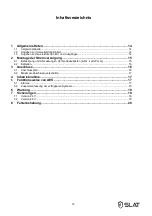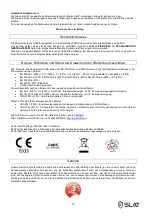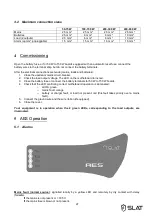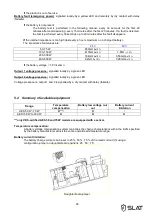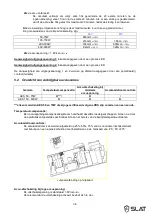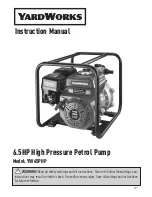
24
1
General information
1.1 Correspondence
table
50 W
75 W
100 W
150 W
200 W
300 W
400 W
600 W
24 V
2 A
3 A
4 A
6 A
8 A
12 A
16 A
24 A
48 V
2 A
3 A
4 A
6 A
8 A
12 A
The currents (
In
) shown are at rated output power.
1.2 Environmental
specifications
Operating temperature:
-5 °C to +40 °C at 100 % charge.
-5 °C to +50 °C at 75 % charge.
-5 °C to +50 °C at 100 % charge for 50 W to 100 W.
Storage temperature: -25 to +85 °C.
Relative humidity: 20 to 95 %.
Heat capacity
consult our website:
www.slat.com
Environment class: 1 (according to EN 12101-10)
1.3 Electrical input and output specifications
1.3.1 Network input
-
single-phase voltage: 195 V to 264 V.
-
frequency: 50 to 60 Hz.
-
class I.
-
neutral systems: TT, TN, IT.
50 W
75 W
100 W 150 W 200 W 300 W 400 W 600 W
Primary current @ 195 V
0.4 A
0.5 A
0.75 A
1 A
1.5 A
2 A
3 A
4 A
Circuit breaker to be provided upstream: D curve
1.3.2 Output
Rated voltage
24 V
48 V
Floating voltage set at half-load and at 25 °C.
27.2 V
±0.5 %
54.4 V
±0.5 %
Max. output voltage.
28,58 V
57,16 V
Min. output voltage
20,95 V
41,90 V
The AES version can function without load current
Imin = 0
The output current In max. can be used on a
single outlet or distributed among all outlets.
In
Maximum specified output current that can be
supplied continuously. (C=battery capacity).
I max a = In –C/20
Maximum specified output current greater than I
max a, that can be supplied for a short period of
time during which battery charging is not required.
I max b = In
Switching time
0s



